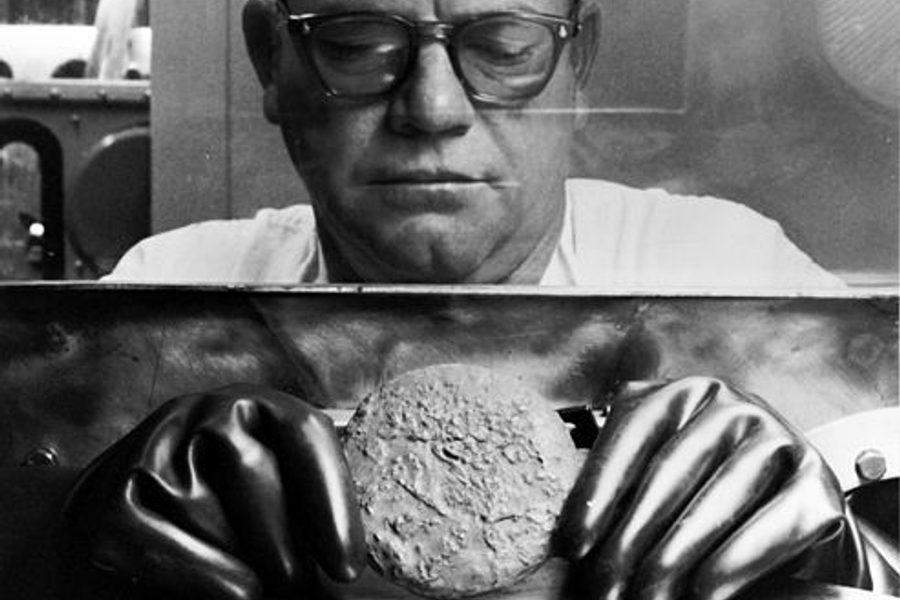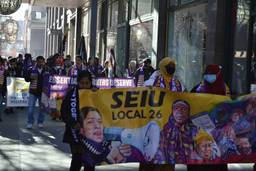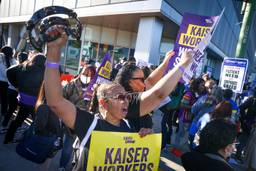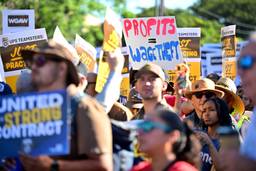
BOULDER, COLO. — When the Green Bay Packers score, fans pound thunderously on the corrugated metal wall of the patio at the Rocky Flats Lounge. Newcomers to the area would likely never guess that in decades past, the tavern between Denver and Boulder would be packed with workers involved in a secretive, controversial and dangerous industry…and that the expanse of wind-swept, weedy, rubble-strewn land across the highway from the tavern was where private contractors working for the U.S. government constructed atomic bombs out of tons of plutonium and other radioactive and toxic elements.
Weapons production halted at the Rocky Flats plant in 1992, and most of the buildings have been dissembled and 80 percent of the area is officially designated a wildlife refuge. But as journalist and University of Colorado Professor Len Ackland told me recently, “the Rocky Flats story is still going on.”
Much of the 10-square-mile grounds are still so contaminated that the U.S. Fish and Wildlife Service, which runs the wildlife refuge, refuses to take possession of it. Hundreds of former workers are still suffering from cancer, beryllium poisoning and other diseases likely caused by their work, and many workers and their survivors are still battling to obtain compensation from the government. In addition, the plutonium bombs manufactured at Rocky Flats exist within the thousands of nuclear weapons comprising today’s U.S. arsenal.
Ackland’s 2002 book Making a Real Killing: Rocky Flats and the Nuclear West tells the harrowing and gripping tale of Rocky Flats, those who worked there and those who fought to have the facility shut down. It describes how workers hired by Dow Chemical Corporation and then Rockwell International, the private companies contracted to run the facility, worked under intense time pressure to churn out nuclear weapons (euphemistically called “triggers” because they were used to set off even more powerful hydrogen bombs)…leading to rampant safety violations, accidents and fires.
Exposure to radiation was a common occupational risk, with many workers accumulating a “body burden” of radiation by inhaling plutonium dust that would lodge in their system and continue to emit radiation from inside their bodies. The workers were originally represented by the United Mine Workers of America (UMW), until the union soured on the nuclear industry because they saw nuclear power as competing with their bread and butter — coal.
Then the United Steelworkers of America took over, and activist union workers struggled to balance their demands for safer conditions with the desire to defend their mission and their jobs from the protests of environmentalists and anti-war activists.
I spoke recently with Ackland about the labor legacy of Rocky Flats, a story which continues to unfold two decades after the last bombs were turned out.
You’ve described the official narrative where the Rocky Flats workers are depicted as “Cold War Heroes” who played a key role in “winning” the Cold War. It sounds like this narrative is used to deflect criticism or re-examination of the whole nuclear industry and the harm done to workers. Do you see any current parallels with workers in the defense industry today?
The difference is the Cold War is over and the war on terror is a perpetual war, so it would be hard to make the same connections. Maybe with workers building drones. You certainly have it with the military. The Cold War, since it was a global confrontation – since it was “cold”…you didn’t have the military playing the same role. So the workers for the Cold War were the ones who “fought” the war, who built the bombs that provided “deterrence.” It’s interesting to think about the workers themselves and their own thoughts and feelings about it – how did they perceive the fact that they were building nuclear weapons of mass destruction?
But they didn’t look at it that way – they knew it was happening but they created a whole language to deal with it. Many of the workers don’t like to talk about Rocky Flats as a bomb factory – they like to talk about it as building components. The most wonderful euphemism was that Rocky Flats built nuclear “triggers.” You get this image of a pistol and you pull the trigger, when what they built were successors to the Trinity test and Nagasaki plutonium bombs and that “triggered” hydrogen explosions (in H-bombs that became the standard in the mid-1950s). When you look at the media coverage of Rocky Flats, every time someone new came on the beat they would inevitably use the term “nuclear triggers” – I would call them and say, “You don’t understand, this is what Rocky Flats did…”
How did the fact that private contractors with a profit motive were running things at Rocky Flats affect conditions for workers and the safety situation? Would things have been a little better if the government was operating the plant directly?
It’s hard to say, you’d have to find a comparison, a facility where the government was actually running the operation. There was a difference between Dow and Rockwell (which replaced Dow). The conditions were better under Rockwell than they were under Dow, but they were still bad. Because of the national security aspect it was all secret – secrecy breeds unaccountability.
You didn’t have OSHA (the Occupational Safety and Health Administration) going in there. On the environmental level, you had the EPA with some jurisdiction, but they didn’t have jurisdiction over nuclear weapons for a long time. There were huge fights: are the materials toxins or radioactive? Radioactive materials were controlled under the Atomic Energy Act. There were all kinds of jurisdictional issues.
Do you think the government has learned from Rocky Flats and improved its practices in nuclear facilities like Los Alamos today?
They’ve improved some. Even at Rocky Flats itself, you see file photos (of the plant’s later years) where workers in the beryllium section have full respirators. There have been improvements – that’s one of the reasons you have unions. At Rocky Flats you had the Steelworkers union, though one of the problems was they were behind the fences of secrecy.
You had the unions and the workers pushing for better working conditions and benefits just like you would have in the civilian sector, but because of the national security fence, a lot of the fights took place internally and quietly instead of getting public support. You had strikes at the plant — maybe over transportation issues, truck drivers on strike, and there would be a few small items in local papers but by and large the workers supported — at least publicly — the nuclear weapons enterprise and nuclear power.
Do you think unions — the UMWA or the Steelworkers or organized labor more generally — should have done more to fight for better safety conditions?
They dealt with it at the congressional level – they testified in the late 1950s and 1960s about concerns over radiation. But they were part of the family, part of the national security family. Unions looked at it as kind of an internal fight. (Typically in labor struggles) unions often get support from outside groups – but outside groups in the case of Rocky Flats and other nuclear production facilities were very often the environmentalists or anti-war activists who were regarded by the workers as the enemy. And many of the anti-war activists looked at the workers as the enemy.
The divisions are not easy to make when you look at the history of a plant like this. You have the backdrop that there was never a debate in this country about nuclear weapons until the “freeze” campaign in the 1980s. There were opponents — scientists, the Bulletin of Atomic Scientists — there were some organizations and individual issues, but (until the 1980s) there was never a real debate over should the U.S. be building up these arsenals of thousands of nuclear weapons capable of destroying the earth.
Also in the 1950s, a lot of the initial Rocky Flats workers came out of coal mines and for them Rocky Flats was just the cleanest thing they’d ever seen. There was enough knowledge and enough precautions taken…the factory was really pretty clean, it was high-paying, it was a good job. There was a community of workers, in part built around the secrecy – they were a secret club, even within the plant the plutonium workers who couldn’t even use the word “plutonium” for the first few years (were like another secret club)…I remember an activist referring to the workers as war criminals – and she really meant it.
The workers for their part looked at themselves as defending the country. The government – the highest authority in the country – said this is what we need, and they felt like they were loyal workers. They didn’t like to think about what they were building – that’s why they called them “devices,” and many still don’t like to refer to them as bombs. To this day in dealing with (plans for a) Rocky Flats Cold War museum, there are some workers who say, “Yeah we need to have exhibits that show the protests as well as the production,” and some workers who don’t want any questions asked publicly about what was done. They fully believe they were in the right, they were doing the country’s work, and no one should question it.
How did workers’ attitudes shift and evolve over the years since the plant closed?
Once production halted, the mission became cleanup, and workers for the first time really began talking about health issues. (During production) there was a lot of denial anything was wrong at the plant because they didn’t want to bring attention that might cost them their jobs. After that there was a big change in that I found workers much more willing to talk about health and compensation.
But it’s still pretty hard for someone who’s spent a career producing something to turn around and say “I really shouldn’t have been doing that.” Former workers still feel pretty strongly about what they did and why they did it.
In retrospect, should the anti-war and environmental activists have been much more sensitive to workers’ point of view?
In the mid-1970s there were a couple women talking to the workers – from the American Friends Service Committee – about job issues, about turning swords into ploughshares. But that effort was undermined by (Pentagon Papers hero and anti-war activist) Daniel Ellsberg and the very public demonstrations that said this factory should not exist and nuclear weapons were terrible. It was hard to bridge that…
There’s certainly more compassion from the anti-war folks in this area toward the workers since it shut down. The workers have gained more allies from the Rocky Mountain Peace and Justice Center – there’s a lot more support particularly for health issues.
In terms of the jobs argument and the workers’ fear of losing their jobs if environmental concerns were raised, do you see any parallels to the Keystone XL pipeline or other current issues?
The Keystone jobs issue is so blown out of proportion – the range of jobs they talk about is unbelievable. In any case it’s really important for environmental groups to be more inclusive and more sensitive to working people’s issues and vice versa. It’s very hard, we live in a society where the income inequality between the rich and everybody else is so large, and because this is such a money-driven society, a small group of people with big financial resources can drive wedges between people who should be allied but get conned into believing their interests lie with the rich rather than the people they’ve been pitted against.
Your book describes the role media played. Reporters were very slow to take a hard look at Rocky Flats, but when they eventually did start asking hard questions, that was part of what led to changing public attitudes and the eventual shutdown. Given all the changes and layoffs in media today, in a situation similar to Rocky Flats would we be missing that watchdog role?
Well, the Rocky Flats story isn’t over — there are still workers trying to get compensation under the compensation law of 2000, and being refused compensation because they can’t prove their cancers were caused by radiation exposure. Because of the way medical science and epidemiology works, whenever a workers compensation claim was made for cancer they (the government and contractors) always claimed it was smoking-induced.
The problem with cancer is that it’s very hard to pin down the cause. The one set of workers clearly injured and sometimes killed (by their work) were the workers exposed to beryllium. Well, over 100 have already died, and there are many more cases of chronic beryllium disease, it’s fatal and there’s no cure. Laura Frank was doing a great job covering the plight of the workers at Rocky Flats for the Rocky Mountain News.
Then the Rocky shut down, and now really no one is covering it on a regular basis. So (the lack of watchdog journalism has) already happened …Even when there were more newspapers around there was pretty sparse coverage. I did an article for a law journal describing the three periods of media coverage. First it was “Ask no questions,” from the beginning of the plant in 1951 to the 1969 fire. During that period journalists were all part of the same mindset – this is the Cold War, Rocky Flats is national security, we can’t pursue stories about that.
After the 1969 fire, because of clouds of smoke seen from the Boulder turnpike and other places, there began a new period of asking a few questions about what was going on at the plant. The end of that period were whistleblowers in the 1980s… and then the third period started with the FBI raid in 1989. After that Rocky Flats was fair game. (Overall) the media didn’t do a great job in terms of covering the issues involved there, which raises questions about how the media cover national security issues, period.
Do you think the Obama administration right now, specifically the U.S. Department of Labor, has a responsibility to make it a priority to resolve compensation claims for Rocky Flats workers and revisit some of the cases where workers were denied compensation?
Yes, definitely…We know about one out of five people are going to die of cancer just in the general public – that’s used as one of the excuses for not compensating workers.
But my feeling is these people had tough jobs, they deserve compensation – you don’t have to call them Cold War Heroes to say, “Look, these people did these jobs in a situation where the government and contractors were deceiving them about the health risks.” The toxicity of beryllium was known even in the 1940s and 1950s – but you see photos of workers on the beryllium section eating sub sandwiches without any protection. It was outrageous what was done. The workers for humane reasons deserve compensation – anyone who worked there should get that compensation.

I hope you found this article important. Before you leave, I want to ask you to consider supporting our work with a donation. In These Times needs readers like you to help sustain our mission. We don’t depend on—or want—corporate advertising or deep-pocketed billionaires to fund our journalism. We’re supported by you, the reader, so we can focus on covering the issues that matter most to the progressive movement without fear or compromise.
Our work isn’t hidden behind a paywall because of people like you who support our journalism. We want to keep it that way. If you value the work we do and the movements we cover, please consider donating to In These Times.
Kari Lydersen is a Chicago-based journalist, author and assistant professor at Northwestern University, where she leads the investigative specialization at the Medill School of Journalism, Media, Integrated Marketing Communications. Her books include Mayor 1%: Rahm Emanuel and the Rise of Chicago’s 99%.







